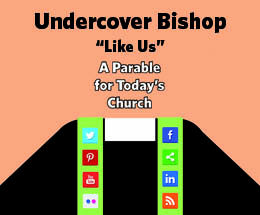 A New Church Tape Measure
A New Church Tape Measure
How Do We Measure Ministry?
The Old List of Statistics
One of the churches I grew up in had an usher/greeter stationed at the door to the sanctuary. With his right hand he shook the hand of each congregant as he or she entered the door. Behind his back, in his left hand, was a counter. He’d tap the button and tally the attendance. Most people had no idea they were a walk-in statistic.
In the same church in the hymnal rack were communion cards. Congregants taking a place at the communion table would drop proof of their presence in the offering plate. These would be forwarded to the church secretary who kept a big book with the name of each church member and their communion history.
A third measure is offering history kept as much for tax purposes as pledge purposes.
The church governing board will keep track of the income and expenses and asset values. At the end of the year, all of this valuable information will be forwarded to the denominational headquarters.
The problem is that this information is helpful mostly to professional leaders, specifically those considering a call. Does this congregation have enough money and a support base to afford pastoral services? is the question on their minds.
We are measuring these things out of tradition based on what was practical to measure in years past. A person sitting in the sanctuary is easily counted. A dollar placed in the offering plate can be added to the other dollars and counted.
Little of this information is of use to mission planning. It was probably NEVER a measure of true viability.
In Search of More Useful Statistics
If growth and mission are goals, the Church needs to start measuring things that matter—things that were impossible to measure years ago.
It is a new world. There are many ways to measure statistics that are far more helpful to mission planning. The more detail you have, the clearer your mission plan will be.
Here are statistics that are more important to mission and church growth.
- Participation in church activities
How many attend every niche activity? How many youth take part in youth groups? How many children are in the nursery school? How many helped with the walkathon or mission project? How many attend midweek services or socials? - Where people come from
Many churches keep statistics on race. They do this a bit apologetically. It’s to measure their progress in fostering diversity, they’ll say. This is not a statistic that really matters. What matters is how do people learn about your church? What is their entry point? Was it a program? Was it through a network of friends or acquaintances? Did they learn about you on your website? Did they read about your project in the news? This type of information tells you which evangelism efforts are effective. - Age demographics
This information helps you plan a bigger picture. If your congregation is aging, you are going to need to find a way to reach younger demographics. If you are attracting unaccompanied children (common in urban neighborhood churches) you’ll need to plan supervision for their nurturing and involvement, especially reaching the adults in their lives. - Membership cycle
We are borrowing a concept from marketing. Businesses track how long it takes a person who expresses interest in a service or project to actually make a purchase? It is called the “sales cycle” and is often depicted as a funnel. You place all your prospective customers at the top and widest part of the funnel. Then you track their engagement as they filter through the ever-narrowing channel that leads to their conversion. If they drop out of the funnel before reaching the bottom, sales people want to know why. At the bottom of the funnel are the prospects who actually buy and hopefully form a brand loyalty. It’s called conversion. Conversion: one of those marketing words that evangelists share!
The same process is vital to successful mission. How long does it take a visitor to your church to become engaged and join? What happened on their journey through the “membership funnel”? Why did some drop out? At what point did they lose interest? How can you improve the experience for other visitors? - Ongoing engagement or member retention
It is not unusual for an excited new church member to suddenly disappear or slowly become less engaged. Often, they don’t quit or transfer; they just stop showing up. Do you have a way of tracking this and addressing any problems. Their waning engagement could be demands or problems in their personal life—or they might have felt snubbed. If you don’t know, you can’t help them—and that’s the ongoing part of mission. - Member interests, problems and goals
The church has a tendency to pigeon-hole members. We encourage youth, but once you reach maturity, you are what you are. This has changed. We have reached an age of life-long learning. People are expected to retrain constantly. They are not going to feel comfortable participating in the world of church if they cannot grow. Churches must know member interests and provide channels to nurture and use new skills. - Engagement outside of Sunday morning
Today’s culture makes it impossible for some to attend church on Sunday morning. Some spiritual people have no interest in Sunday morning worship. They may still consider themselves loyal members, and they may have valuable skills that you need.
How can churches measure all of this?
It’s easier than it might seem.
A church BLOG provides these statistics—all built into the software. It takes some skill to offer the kinds of content that promote engagement that will give the best results, but within a year or two you’ll have a new picture of your congregation that will help you plan and carry out your mission.
- You’ll be able to count views.
- You’ll be able to see what pages attract the most interest.
- You’ll be able to track whether they reached you through Facebook or what words they plugged into their search engine to find you.
- You’ll be able to communicate directly with anyone who subscribes.
- You’ll be able to see which days of the week and hours of the day get the most traffic. No need to schedule everything on Sunday morning.
- You’ll get an idea of where people are from. It might surprise you to find that you might be engaging with people all over the world.
- You’ll be able to track when people unsubscribe and that information can influence your mission.
- You’ll be able to see skills and interests in profiles which they choose to make available online.
- You’ll be able to plan educational offerings that connect with your readers.
- You’ll be giving them a safe place to explore their relationship with God and his people.
If a congregation tracks these kinds of things and looks at weekly progress, they will be less likely to wallow in the status quo.
In addition, the blog is living evidence of your commitment to your community. You have a platform that is not defined by your church walls. You can use that platform to address neighborhood interests. You are no longer waiting for people to come to you; you are going to them. It’s the kind of social proof that younger generations expect.
Yet practically NO churches have a blog.
How do you account for that?




